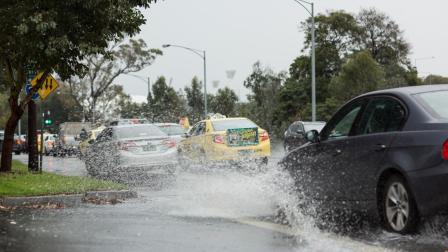As our city grows and our climate changes, more properties across Melbourne will be at risk of flooding. But by understanding your flood risk and taking a few simple actions, you can be prepared.
Preparing your home
Know your flood risk
- Check if your suburb has a VICSES Local Flood Guide.
- Download the VicEmergency App and set your warning settings.
Check your insurance
- Check if your home insurance policy covers flood and stormwater damage, and make sure you understand any exclusions or limitations.
- Store copies of your insurance documents in a secure, accessible location.
Prepare your emergency plan and flood kit
- Create an emergency plan for your home or business to record key contact details and other important information.
- Pack an emergency flood kit with at least three days’ worth of essentials, in case you lose power or need to evacuate.
- Download checklists, templates and resources to help you plan from the VICSES website.
Protect your home
- Clear debris from gutters and drains.
- Seal any cracks or gaps in your home’s foundations.
- Check that you have sandbags or know where to get them.
Secure your belongings
- Store important documents and valuables in waterproof containers, or create digital backups.
- Make sure power points, switchboards, electronics, appliances and furniture are positioned above expected floodwater levels.
For more information, download:
Retrofitting flood-affected homes
If you own a home in a flood-affected area, you can reduce the impact of future flooding by applying methods and materials that are less prone to damage – and saving costs in temporary relocation and repairs. Find out more:

Staying safe in a flood
Your safety is the top priority during a flood. Floodwaters are powerful enough to destroy roads and bridges, and can contain pollutants and hidden debris.
Need help? For life-threatening emergencies, call Triple Zero (000). For flood emergency help, call the Victoria State Emergency Service at 132 500.
- Monitor weather warnings on ABC Radio or via VicEmergency’s website, app or hotline (1800 226 226)
- Never drive through floodwater – just 15cm of water can float a small car
- Register at a Relief Centre or with your local council for help
- Evacuate early if you’re told to, and wait for official clearance before returning home.
Preparing your community
By staying informed and working together, you can help build a flood-resilient community.
Here’s how you can do your part:
- Connect with local authorities for workshops, resources and updates
- Start a flood action group to coordinate emergency plans
- Organise community cleanup events to prevent flooding before it starts
- Promote flood awareness in your community so everyone knows what to do in an emergency
- Support green infrastructure, like raingardens and permeable pavements, which help to absorb stormwater.
You may also like...
Flooding and its impacts
Floods are a natural part of our weather cycle. Know the types of flooding that could occur and how they might impact you.

Visit the VICSES website for more information on how to plan and prepare for floods.
This free disaster preparedness guide has tips and strategies for making an emergency plan.



